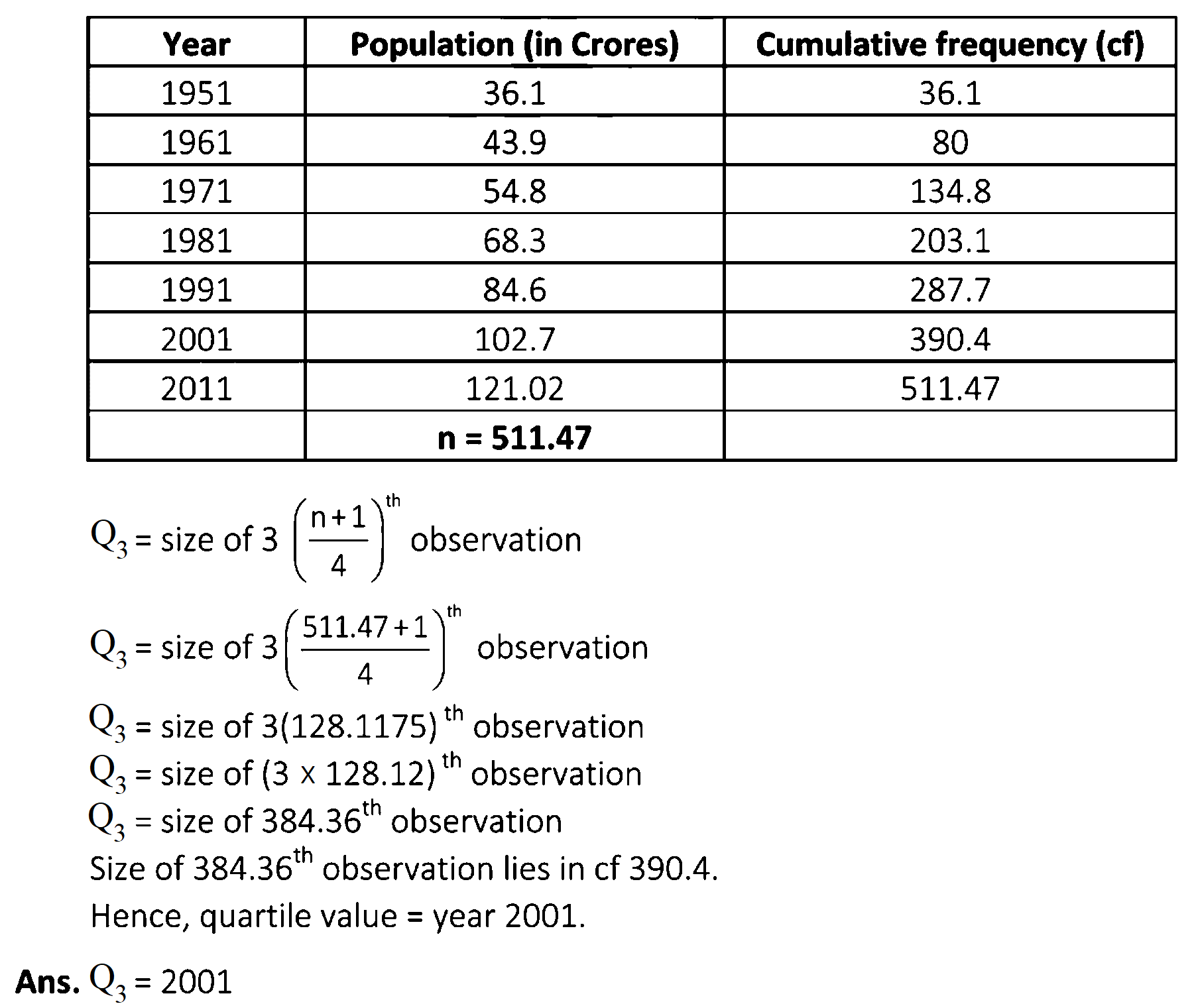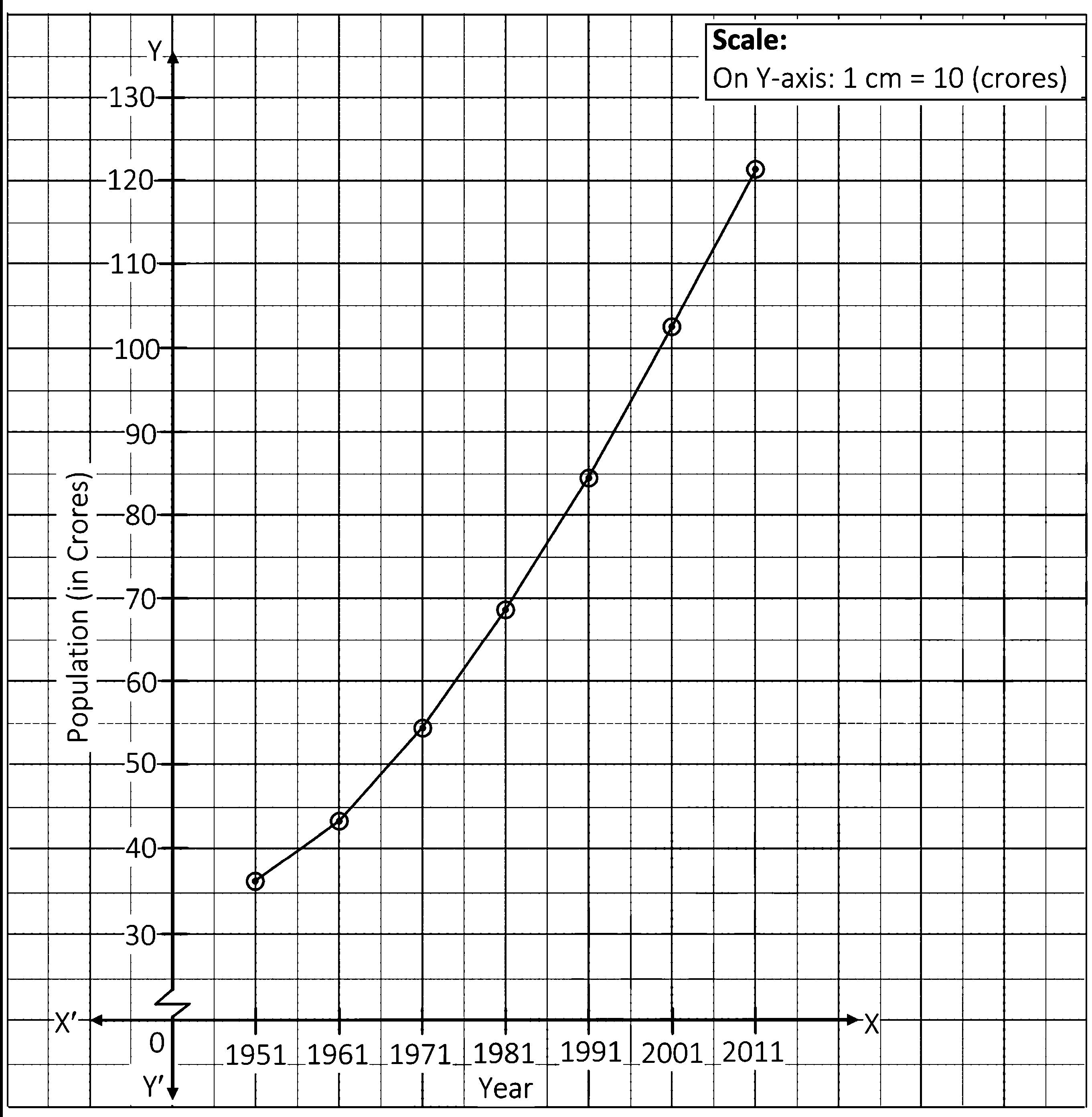Q. 1. Choose the correct option :
1) Stages of the theory of demographic transition.
a) High birth rate and high death rate
b) High birth rate and low death rate
c) Low birth rate and low death rate
d) Economic development
Options :
1) a and b
2) a and c
3) a, b and c
4) a, b, c and d
Ans. (4) a, b, c, and d
2) Incorrect reasons for population explosion in India.
a) Illiteracy
b) Universalization of Marriage
c) Joint family system
d) Upliftment in lifestyle
Options :
1) a and b
2) c and d
3) a, b and c
4) d
Ans. (4) d
3) Remedies undertaken to check population explosion.
a) To provide employment
b) To improve women’s quality of life
c) National Population Policy
d) Disaster management
Options :
1) d
2) a and c
3) c and d
4) a, b and c
Ans. (4) a, b and c
4) Choose the correct option.
Options :
1) 1-d, 2-c, 3-a, 4-b
2) 1-b, 2-c, 3-d, 4-a
3) 1-b, 2-a, 3-c, 4-d
4) 1-c, 2-d, 3-a, 4-b
Ans. (2) 1-b, 2-c, 3-d, 4-a
Q. 2. Give economic terms :
1) Increase in population is faster than economic growth and development.
Ans. Increase in population is faster than economic growth and development.- Population explosion.
2) Difference between birth rate and death rate.
Ans. Difference between birth rate and death rate. – Survival rate.
3) Balance between natural resources and population growth.
Ans. Balance between natural resources and population growth – Optimum population.
4) Programme introduced to reduce the birth rate in 1952.
Ans. Programme introduced to reduce the birth rate in 1952– Family planning Programme.
Q. 3. Identify and explain the concepts from the given illustrations :
1) There were 40 births per 1000 in country ‘A’ during a year.
Ans.
(A) Identified concept: Birth rate
(B) Explanation of concept: The number of births occurring per thousand of the living population during a year is called birth rate. In the above illustration, the birth rate is 40.
2) In Mumbai city, public transport service is largely affected due to the growing population.
Ans.
(A) Identified concept: Pressure on infrastructure.
(B) Explanation of concept: Growing population adversely affects the infrastructure and basic amenities. This is known as pressure on infrastructure.
3) In country ‘B’, there are 15 deaths taking place per 1000 during a year.
Ans.
(A) Identified concept: The death rate
(B) Explanation of concept: The number of deaths per thousand of the living population during a year is called the death rate. In the above illustration, the death rate is 15.
4) For a certain period of time China had adopted the policy of ‘One child per family’.
Ans.
(A) Identified concept: Family Planning
(B) Explanation of concept: Family planning policy/program is a measure to control the growing population in Which birth of a child is determined. by choice and not by chance.
Q. 4. Answer the following :
1) Explain the causes of high birth rate.
Ans.
The causes of high birth rate are as follows:
- Illiteracy: The percentage of illiterates in the country is reasonably high. The attitude of illiterate people towards marriage and child birth has remained rigid. A low level of literacy among females is also responsible for a high birth rate.
- Universalization of marriage: In India, marriage is considered as both religious and social obligation. Even with the spread of education, the attitude of people towards marriage remains unchanged at large.
- Age of marriage: In India, the legal age of marriage is relatively lower compared to other countries. It is 18 years for females and 21 years for males. The low age of marriage has also resulted in a high birth rate.
- Preference for the male child: Many Indian parents are opting to continue having children until they have a son or desired number of sons. This is known as son meta-preference.
- Joint family system: There is no individual financial responsibility in a joint family. Hence, the existence of a joint family is also responsible for the high birth rate in India.
- Dependence on Agriculture: Indian agriculture is driven by manpower. In India, there is overdependence on agriculture. More number of children in the family implies more labor force available for fieldwork.
- Widespread Poverty: Poor people prefer large families because they feel that more children mean greater economic support. Lack of awareness about family welfare services: In India, due to illiteracy, ignorance, etc. most of the people are unaware of the availability of various means and techniques of family planning.
2) Explain the causes of low death rate.
Ans.
The causes of low death rate are as follows:
- Improvement in medical and health facilities: In India, in the post-independence period, the availability of medical and health facilities have improved. As its effect, epidemics like a plague, cholera, malaria, smallpox, tuberculosis, etc. have almost been eradicated.
- Decline in maternal mortality rate: Death rate of women dying during maternity has declined due to improvement in medical facilities.
- Fall in infant mortality rate: Due to better medical facilities and increased literacy among women, there has been a decline in infant mortality rate from 146 per 1000 in 1951 to 64 per 1000 in 2002 and 47 per 1000 in 2011.
- Increase in literacy: In India, the spread of education has helped the people to take care of their life and the needs of their children in a better Way. Education has helped people to come out of their blind faith, beliefs, and ignorance.
- Use of nutritious food: In India, the spread of education has created awareness about health and nutrition among people. For many decades, the percentage of children and women dying due to malnutrition and ill health was quite high. These deaths are now brought under control by providing a nutritious diet. e.g. Mid-day meal programs in schools.
- Disaster management: The National Disaster Management Authority (NDMA) was constituted in 2005. NDMA helps to mitigate all. types of disasters. This has helped in reducing the loss of lives. Other factors: Education, social reforms, rapid urbanization, improvement in the standard of living, publicity campaigns are also responsible for creating awareness among the people thereby reducing the death rate.
3) Explain the role of Human Resource in Economic development
Ans.
The causes of low death rate are as follows:
- Improvement in medical and health facilities: In India, in the post-independence period, the availability of medical and health facilities have improved. As its effect, epidemics like a plague, cholera, malaria, smallpox, tuberculosis, etc. have almost been eradicated.
- Decline in maternal mortality rate: Death rate of women dying during maternity has declined due to improvement in medical facilities.
- Fall in infant mortality rate: Due to better medical facilities and increased literacy among women, there has been a decline in infant mortality rate from 146 per 1000 in 1951 to 64 per 1000 in 2002 and 47 per 1000 in 2011.
- Increase in literacy: In India, the spread of education has helped the people to take care of their life and the needs of their children in a better Way. Education has helped people to come out of their blind faith, beliefs, and ignorance.
- Use of nutritious food: In India, the spread of education has created awareness about health and nutrition among people. For many decades, the percentage of children and women dying due to malnutrition and ill health was quite high. These deaths are now brought under control by providing a nutritious diet. e.g. Mid-day meal programs in schools.
- Disaster management: The National Disaster Management Authority (NDMA) was constituted in 2005. NDMA helps to mitigate all. types of disasters. This has helped in reducing the loss of lives. Other factors: Education, social reforms, rapid urbanization, improvement in the standard of living, publicity campaigns are also responsible for creating awareness among the people thereby reducing the death rate.
Q. 5. State with reasons whether you agree or disagree with the following statements :
1) India is experiencing population explosion.
Ans.
Yes, I agree with this statement.
Reasons:
- During the same period, the death rate rapidly declined from 22.8 to 7.48.
- During the same period, the population increased from 36.11 crores in 1951 to 121.02 crores in 2011.
- India’s population is not merely large but it is also increasing at an alarming rate and population explosion has become a major problem In India’s economic development.
Thus, India is experiencing a population explosion.
2) Death rate is falling rapidly in India.
Ans.
Yes, I agree with this statement.
Reasons:
- In the post-independence period, with advances in medical and health facilities, epidemics like the plague, cholera, malaria, smallpox, tuberculosis, etc. have almost been eradicated.
- An increase in literacy among women has led to a decline in the infant mortality rate.
- The National Disaster Management Authority (NDMA) helps to mitigate all types of disasters. This has helped in reducing the loss of lives.
- Due to other factors like social reforms, rapid urbanization, publicity campaigns, etc. the death rate has declined. The death rate in India has fallen rapidly from 19.0 in 1961 to 7.48 in 2011.
Thus, death rate is falling rapidly in India.
3) Optimum population contributes economic development of a country.
Ans.
Yes, I agree with this statement.
Reasons:
- In the condition of the optimum population, there is a balance between population growth and availability of natural resources.
- In the condition of underpopulation, natural resources are underused Which leads to limited economic development.
- In the condition of overpopulation, natural resources are overused. This adversely affects economic development.
- In the condition of the optimum population, natural resources are used at an optimum level which leads to optimum economic development.
Thus, the optimum population contributes to the economic development of a country.
4) Human resources play an important role in economic development.
Ans.
Yes, I agree with this statement.
Reasons:
- The development of human resources reduces civil disturbances and increases political stability.
- The development of human resources helps in controlling the increasing population.
- The development of human resources helps in increasing human productivity.
- The development of human resources widens economic, social, cultural, and political choices.
Thus, human resources play an important role in economic development.
5) Birth rate is declining due to changes in the standard of living
Ans.
Yes, I agree with this statement.
Reasons:
- An increase in the standard of living is helping in bringing change in the attitude of people towards marriage and childbirth.
- Change in the standard of living is also responsible for making people aware of family planning and the need for small families.
- Change in the standard of living has helped people to come out of superstitions, beliefs, etc.
- Change in the standard of living has increased the income level in a country, leading to a decline in the birth rate.
Thus, the birth rate is declining due to changes In the standard of living.
Q. 6. Solve the following :
1) Find out Q3 from the given data.

Ans.
2) Draw a population growth curve from the given data

Ans.